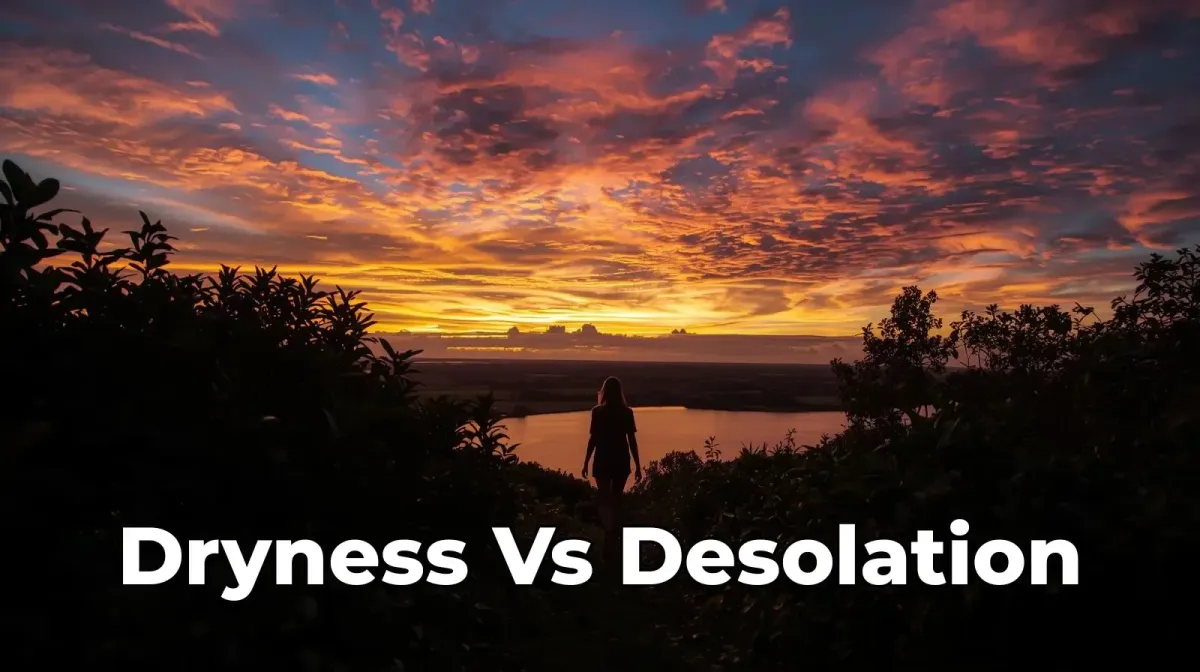Peter Paul Parker's Official Website
Articles And Guidance

Dark Night: Dryness vs Desolation (Gentle Guide)
Sometimes the spiritual path goes quiet. Prayer feels flat. Meditation feels empty. You’re still showing up, yet there’s little warmth or guidance. This can be spiritual dryness. Other times, the quiet is heavier — hope thins, meaning blurs, and the heart aches.
That depth of struggle is closer to spiritual desolation. Knowing the difference helps you respond with kindness, safety, and skill.
New here? Start with the cornerstone overview: Spiritually Lost (Complete Guide)
What’s the difference?
Spiritual dryness
Feels like the light is dimmed, not gone.
Routine still holds: you can sit, pray, or journal — just feels flat.
Life functions remain mostly intact. You’re tired, not unravelled.
Often invites patient simplification: shorter practices, softer expectations.
Good companions: Art of Surrender During Dark Night, Reconnect Intuition When Guidance Runs Dry
Spiritual desolation
Feels like the light is absent and the world is colder.
Meaning collapses; emotions swing to emptiness, guilt or despair.
Functioning can shrink: sleep, appetite, and relationships suffer.
Needs containment and care: more structure, stronger anchors, supportive people.
Stability helps: Spiritual Overload: Find Clarity and Focus, Spiritual Loneliness: Find Support When Lost
If you’re unsure, treat it as desolation and add more safety and support. You can always loosen later.
A kind self-check (2 minutes)
Signals of dryness: “I’m tired of trying”, “This used to feel alive”, “I’m bored but OK”.
Signals of desolation: “What’s the point?”, “I’m failing spiritually”, “Nothing helps”, “I feel empty or ashamed”.
Body cues: Can you extend your exhale a little and feel a small softening? Dryness often allows a tiny ease; desolation often doesn’t.
Gentle map: Window of Tolerance: HSP Quick Map
First, stabilise the nervous system
Before big meaning questions, settle the body. Small, reliable anchors make the difference.
Breath: Even inhale/exhale with a slightly longer exhale.
Support: Vagus Nerve Breathing Patterns for HSPsTouch: Hand on heart/belly; a warm mug; a scarf around shoulders.
Sight & sound: Find three soft colours; hum or listen to a neutral room sound.
Fast resets: 2-Minute Body Resets for HSPs
If your system won’t settle, think desolation and go smaller, slower — and add support.
Practices for dryness (keep it simple)
Tiny presence (3 minutes)
Sit; soften jaw/shoulders; breathe evenly. Whisper: “I’m here.” No fixing. Just presence.One-line prayer/intention
Choose a single sentence and repeat gently: “Be with me as I am.” or “Light, even when unseen.”Micro-surrender
Release the idea of “how it should feel” for today only. Show up for the form, not the feeling.
Helpful: Art of Surrender During Dark NightQuiet service
Do one small kind act without seeking a feeling in return. Dryness often softens through embodied love.
Practices for desolation (containment + care)
Anchor-first routine (5 minutes, twice daily)
Breath anchor → touch anchor → sight/sound anchor → stop. No evaluation. Build trust before any deeper practice.
Rebuild trust: Somatic Tracking for HSPs: Build Body TrustPendulation (very small dose)
5–10 seconds noticing a body cue (tight chest) → 60–90 seconds anchor. One cycle only. End with “Enough for now.”
How-to: Pendulation for HSPs: Ease Your Nervous SystemBoundaried reflection
Two lines of journaling, then close the notebook. No analysis spirals.
If shame spikes: Self-Compassion for HSPs: Soften Shame, Build Inner SafetyGentle movement
5 minutes of loosening: shoulder rolls, hand shaking, mini spinal wave.
Blend breath + movement: Qi Gong for Emotional Healing: Move, Breathe, Release
Common pitfalls (and kinder alternatives)
Hunting for lost highs → Anchor in steady lows. Choose form over fireworks.
Spiritualising overload → Check the body first. If fried, rest before practice.
*Self-blame (“I’m failing”) → Normalise seasons. Dryness and desolation visit sincere seekers.
Going deeper when flooded → Go smaller. Shorten exposure; lengthen anchoring.
For safe pacing: Shadow Work Titration: Safe, Small Steps
7-day micro-plan
Day 1–2 — Anchor-only (3–5 mins morning/evening).
Day 3 — Add one-line intention. End with a sigh or swallow.
Day 4 — Two minutes of gentle movement + anchor.
Day 5 — If steady, add a single minute of quiet sitting.
Day 6 — One small service act; write one sentence about it.
Day 7 — Review: What softened? What still needs more safety?
Sleep support if nights are choppy: Sleep for Emotional Healing (HSP Edition)
When to seek extra support
Frequent panic/dissociation or intrusive thoughts.
Daily functioning narrows (withdrawing from people/places).
Spirals of shame, despair, or thoughts of self-harm.
History of complex trauma and current flooding.
Start with safety: Shadow Work Safety: Myths, Risks and Red Flags
Helpful companions:
DBT Skills for HSPs: Gentle Tools
ACT Defusion and Values for HSPs
IFS (Parts Work) for HSPs: Befriend Your Inner Team
Further reading
Spiritually Lost (Complete Guide)
Art of Surrender During Dark Night
Reconnect Intuition When Guidance Runs Dry
Spiritual Loneliness: Find Support When Lost
Spiritual Overload: Find Clarity and Focus
What Is a Highly Sensitive Person?
FAQs on dryness versus desolation
Is dryness a sign I’m doing it wrong?
No. Dryness is a normal season. Show up simply; let the ego’s demand for “feeling it” rest for now.
How do I tell dryness from depression?
Dryness is flat but functional; depression often disrupts sleep, appetite, energy, and hope. If in doubt, seek professional support and stabilise your nervous system.
Can desolation be “just growth”?
Sometimes growth is gritty — but don’t romanticise suffering. Anchor first, go gently, and get help when the weight is heavy.
How long does this last?
It varies. What shortens the season is kind consistency: small anchors, tiny practices, steady support.
Should I stop all spiritual practice?
No — simplify. Keep short, safe forms. If any practice floods you, go smaller or switch to purely somatic anchors for a while.
Discernment checklist (dryness • desolation • depression)
Dryness (simplify & stay steady)
Flatness without collapse; routine is doable.
A tiny ease sign appears with breath/anchor.
Response: shorten practices, choose form over feeling, add quiet service.
Companion reads: Spiritually Lost (Complete Guide), Art of Surrender During Dark Night
Desolation (contain & resource)
Meaning thins; hope wobbles; energy drops.
Anchors help but you need more time/structure/support.
Response: anchor-first routines, micro-journals, pendulation in tiny doses.
How-to: Pendulation for HSPs: Ease Your Nervous System
Depression flags (seek extra help)
Sleep/appetite changes, persistent despair, loss of interest.
Daily life shrinking, intrusive thoughts.
Response: professional support + nervous-system care.
Foundations: Emotional Healing & Emotional Trauma: The Complete Guide
Morning & evening steadiness (2 × 5 minutes)
Morning (5 mins)
Breath (60–90s) — even inhale/exhale, slightly longer exhale.
Touch (30–60s) — hand on heart/belly.
Sight or sound (60s) — three soft colours or neutral room sound.
Presence (60s) — one-line intention: “Be with me as I am.”
Support: Morning Rituals for HSPs: Start Calm
Evening (5 mins)
Gentle movement (60–90s) — shoulder rolls, hand shaking, mini spinal wave.
Breath (60–90s) — extend the exhale.
One-line gratitude/service memory (30s).
Lights down, screens off.
Sleep help: Sleep for Emotional Healing (HSP Edition)
Movement blend: Qi Gong for Emotional Healing: Move, Breathe, Release
Four safety rules for this season
Anchor first. No deep inquiry until you feel a small ease sign (sigh, swallow, warmer hands).
Short caps. 3–7 minutes max per practice; stop while it’s still easy.
No hunting for highs. Choose faithful form over fireworks.
Support beats soloing. If you’re unsure, add a person, a plan, or a gentler pace.
Overwhelm help: Spiritual Overload: Find Clarity and Focus
Compassionate language swaps
“I’m failing” → “I’m in a quiet season; I’m showing up gently.”
“Nothing’s working” → “Small anchors are working; results are subtle.”
“I must push” → “I’ll practise small and stop while it’s easy.”
“I’m alone in this” → “Many travellers pass here; support is wise.”
Soothe the tone: Self-Compassion for HSPs: Soften Shame, Build Inner Safety
Three mini case snapshots
A) Dryness at the cushion
Signs: flat but functional.
Move: 3 minutes anchor + one-line intention + tiny service task.
Optional: Reconnect Intuition When Guidance Runs Dry
B) Desolation on Sunday night
Signs: heaviness, meaning blur, pull to withdraw.
Move: 5 minutes anchor-first routine; two-line journal; brief walk.
Guardrails: Shadow Work Titration: Safe, Small Steps
C) Sound without striving
When words feel empty, let vibration hold you.
Try: humming, a single chime, or soft music as anchor.
Explore: Healing Through Sound, Music & Vibration (Spiritual)
7-day stabilisation plan (copy/paste)
Day 1–2: Anchor-only (morning/evening, 5 mins).
Day 3: Add one-line intention.
Day 4: +2 mins gentle movement before anchors.
Day 5: If steady, 60s quiet sitting after anchors.
Day 6: One small service act; jot one sentence.
Day 7: Review what softened; keep what worked.
Weekly review: Emotional Healing Weekly Review Ritual (HSP)
Extra FAQs
What if anchors don’t work today?
Go smaller and concrete: warmth (scarf/tea), weight (blanket), or sound (hum). If nothing shifts, stop and try again later with support.
Should I change my spiritual path during desolation?
Not usually. Simplify forms you already trust. Review boundaries and nervous-system care first.
Can movement replace formal practice for a while?
Yes. In heavy seasons, five minutes of kind movement plus a single sentence of intention can be your whole practice.
Next steps
If this season feels like dryness or desolation, you don’t have to carry it alone. These two gentle paths give you practical support for exactly what we’ve covered:
Free Soul Reconnection Call — A calm, one-to-one space to settle your system, set spiritual boundaries, and design tiny, repeatable rituals so your practice feels safe, embodied and sustainable.
Dream Method Pathway — A self-paced, 5-step map (Discover → Realise → Embrace → Actualise → Master) to heal old loops, build daily regulation, and integrate spirituality into a stable, meaningful life.

Choose the route that feels kindest today. Both are designed to help highly sensitive people grow spiritually with steadiness and self-trust—gently, steadily, and for real change.
I look forward to connecting with you in my next post.
Until then, be well and keep shining.
Peter. :)
Feeling Spiritually Lost? 🢂
Copyright Peter Paul Parker 2023 <<< ✺✺✺✺✺✺✺✺✺✺✺✺✺✺✺✺✺✺✺✺✺ >>> Terms And Conditions - >>> Privacy - Linked In - YouTube - Facebook -
